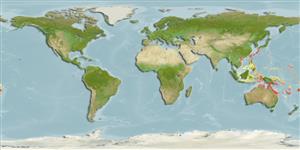>
Anguilliformes (Eels and morays) >
Muraenidae (Moray eels) > Uropterygiinae
Etymology: Cirrimaxilla: Latin, cirrus = fringe, curl + Latin, maxilla = jaw.
Environment: milieu / climate zone / depth range / distribution range
Ökologie
seewasser demersal; tiefenbereich 0 - 5 m (Ref. 86942). Subtropical
Northwest Pacific: known only from Nan-wan, Ping-tung County, Taiwan (Ref. 10992). Reported in New Caledonia, found in the stomach of the sea snake Laticauda (Ref. 77055).
Size / Gewicht / Alter
Maturity: Lm ? range ? - ? cm
Max length : 16.6 cm TL (female)
Kurzbeschreibung
Morphologie | Morphometrie
Wirbelzahl: 132. Body very stout, muscular, elliptical anteriorly, somewhat compressed posteriorly. Dorsal and anal fins restricted to tail end, confluent with caudal fin. Mouth large, lower protruding and slightly curved upward, snout pointed. Jaws with beard-like cirri.
Holotype collected from a tidal pool.
Life cycle and mating behavior
Geschlechtsreife | Fortpflanzung | Ablaichen | Eier | Fecundity | Larven
Chen, H.-M. and K.-T. Shao, 1995. New eel genus, Cirrimaxilla, and description of the type species, Cirrimaxilla formosa (Pisces: Muraenidae) from southern Taiwan. Bull. Mar. Sci. 57(2):328-332. (Ref. 10992)
IUCN Rote Liste Status (Ref. 130435)
Bedrohung für Menschen
Harmless
Nutzung durch Menschen
Mehr Information
NamenSynonymeMetabolismusRäuberÖkotoxikologieFortpflanzungGeschlechtsreifeAblaichenSpawning aggregationFecundityEierEientwicklung
Alter/GrößeWachstumLänge-GewichtLänge-LängeLängenhäufigkeitenMorphometrieMorphologieLarvenLarven Pop.Dyn.RekrutierungDichteBRUVS
ReferenzenAquakulturAquakultur ProfilZuchtlinienGenetikElectrophoresesVererbbarkeitKrankheitenVerarbeitungNutrientsMass conversion
PartnerBilderStamps, Coins Misc.LauteCiguateraGeschwindigkeitSchwimmstilKiemenoberflächeOtolithsGehirngrößeSehfähigkeit
Tools
Zusatzinformationen
Download XML
Internet Quellen
Estimates based on models
Preferred temperature (Ref.
123201): 24.5 - 27.9, mean 26.5 °C (based on 469 cells).
Phylogenetic diversity index (Ref.
82804): PD
50 = 1.0000 [Uniqueness, from 0.5 = low to 2.0 = high].
Bayesian length-weight: a=0.00069 (0.00033 - 0.00144), b=3.12 (2.93 - 3.31), in cm total length, based on LWR estimates for this (Sub)family-body shape (Ref.
93245).
Trophic level (Ref.
69278): 3.4 ±0.5 se; based on size and trophs of closest relatives
Widerstandsfähigkeit (Ref.
120179): hoch, Verdopplung der Population dauert weniger als 15 Monate. (Preliminary K or Fecundity.).
Fishing Vulnerability (Ref.
59153): Low vulnerability (10 of 100).
